Oral Impacts of Aligners versus Fixed Self-Ligating Lingual Orthodontic Appliances
Abstract
:1. Introduction
2. Materials and Methods
Statistical Analysis
3. Results
3.1. Demographic Characteristics
3.2. HRQoL Questionnaires
3.2.1. Baseline (T0)
3.2.2. Day 1 (T1)
3.2.3. Month 3 (T3)
3.3. Speech Evaluation
4. Discussion
5. Conclusions
Supplementary Materials
Author Contributions
Funding
Institutional Review Board Statement
Informed Consent Statement
Data Availability Statement
Conflicts of Interest
Appendix A. Health-Related Quality of Life Questionnaire
- Rate the worst pain you have felt during the past 24 h on a scale of 1 to 10 (1—not at all, 10—very much).
- Have you taken any medication to relieve pain today? (0 = no, 1 = yes).
- 3.
- Has it been difficult to speak today?
- 4.
- Has it been difficult to swallow today?
- 5.
- Has it been difficult to open your mouth today?
- 6.
- Were there any foods you could not eat today?
- 7.
- Have you enjoyed your food today?
- 8.
- Have you noticed a change in your sense of taste today?
- 9.
- Was it difficult to sleep last night?
- 10.
- Does the appliance disturb you at work or when studying today?
- 11.
- Has it been difficult to continue your daily activities today?
- 12.
- Do you have sores on your tongue?
- 13.
- Do you have sores on your cheeks?
- 14.
- Do you have sores on your lip?
- 15.
- Have you had a bad taste or bad smell in your mouth today?
- 16.
- Has there been any food debris under the appliance today?
References
- Rosvall, M.D.; Fields, H.W.; Ziuchkovski, J.; Rosenstiel, S.F.; Johnston, W.M. Attractiveness, acceptability, and value of orthodontic appliances. Am. J. Orthod. Dentofac. Orthop. 2009, 135, e1–e12; discussion 276–277. [Google Scholar] [CrossRef]
- Ziuchkovski, J.P.; Fields, H.W.; Johnston, W.M.; Lindsey, D.T. Assessment of perceived orthodontic appliance attractiveness. Am. J. Orthod. Dentofac. Orthop. 2008, 133, S68–S78. [Google Scholar] [CrossRef] [PubMed]
- Alansari, R.A. Youth perception of different orthodontic appliances. Patient Prefer. Adher. 2020, 14, 1011–1019. [Google Scholar] [CrossRef]
- Pachêco-Pereira, C.; Pereira, J.R.; Dick, B.D.; Perez, A.; Flores-Mir, C. Factors associated with patient and parent satisfaction after orthodontic treatment: A systematic review. Am. J. Orthod. Dentofac. Orthop. 2015, 148, 652–659. [Google Scholar] [CrossRef]
- Xiaoting, L.I.; Yin, T.; Yangxi, C. Interventions for pain during fixed orthodontic appliance therapy. A systematic review. Angle Orthod. 2010, 80, 925–932. [Google Scholar] [CrossRef] [PubMed]
- Oliver, R.G.; Knapman, Y.M. Attitudes to orthodontic treatment. Br. J. Orthod. 1985, 12, 179–188. [Google Scholar] [CrossRef]
- Patel, V. Non-Completion of Orthodontic Treatment: A Study of Patient and Parental Factors Contributing to Discontinuation in the Hospital Service and Specialist Practice. Master’s Thesis, University of Wales, Wales, UK, 1989. [Google Scholar]
- Lew, K.K. Attitudes and perceptions of adults towards orthodontic treatment in an Asian community. Community Dent. Oral Epidemiol. 1993, 21, 31–35. [Google Scholar] [CrossRef] [PubMed]
- Locker, D.; Jokovic, A. Using subjective oral health status indicators to screen for dental care needs in older adults. Community Dent. Oral Epidemiol. 1996, 24, 398–402. [Google Scholar] [CrossRef]
- O’Brien, K.; Kay, L.; Fox, D.; Mandall, N. Assessing oral health outcomes for orthodontics--measuring health status and quality of life. Community Dent. Health 1998, 15, 22–26. [Google Scholar]
- Cunningham, S.J.; Hunt, N.P. Quality of life and its importance in orthodontics. J. Orthod. 2001, 28, 152–158. [Google Scholar] [CrossRef]
- Jokovic, A.; Locker, D.; Stephens, M.; Kenny, D.; Tompson, B.; Guyatt, G. Validity and reliability of a questionnaire for measuring child oral-health-related quality of life. J. Dent. Res. 2002, 81, 459–463. [Google Scholar] [CrossRef]
- Chaushu, G.; Becker, A.; Zeltser, R.; Branski, S.; Chaushu, S. Patients’ perceptions of recovery after exposure of impacted teeth with a closed-eruption technique. Am. J. Orthod. Dentofac. Orthop. 2004, 125, 690–696. [Google Scholar] [CrossRef]
- Chaushu, S.; Becker, A.; Zeltser, R.; Vasker, N.; Chaushu, G. Patients’ perceptions of recovery after surgical exposure of impacted maxillary teeth treated with an open-eruption surgical-orthodontic technique. Eur. J. Orthod. 2004, 26, 591–596. [Google Scholar] [CrossRef] [PubMed] [Green Version]
- Chaushu, S.; Becker, A.; Zeltser, R.; Branski, S.; Vasker, N.; Chaushu, G. Patients perception of recovery after exposure of impacted teeth: A comparison of closed- versus open-eruption techniques. J. Oral Maxillofac. Surg. 2005, 63, 323–329. [Google Scholar] [CrossRef] [PubMed]
- Chaushu, G.; Becker, A.; Zeltser, R.; Vasker, N.; Branski, S.; Chaushu, S. Patients’ perceptions of recovery after routine extraction of healthy premolars. Am. J. Orthod. Dentofac. Orthop. 2007, 131, 170–175. [Google Scholar] [CrossRef]
- Shalish, M.; Cooper-Kazaz, R.; Ivgi, I.; Canetti, L.; Tsur, B.; Bachar, E.; Chaushu, S. Adult patients’ adjustability to orthodontic appliances. Part I: A comparison between Labial, Lingual, and Invisalign™. Eur. J. Orthod. 2012, 34, 724–730. [Google Scholar] [CrossRef] [Green Version]
- Bräscher, A.K.; Zuran, D.; Feldmann, R.E., Jr.; Benrath, J. Patient survey on Invisalign® treatment comparing the SmartTrack® material to the previously used aligner material. J. Orofac. Orthop. 2016, 77, 432–438. [Google Scholar] [CrossRef]
- Fujiyama, K.; Honjo, T.; Suzuki, M.; Matsuoka, S.; Deguchi, T. Analysis of pain level in cases treated with Invisalign aligner: Comparison with fixed edgewise appliance therapy. Prog. Orthod. 2014, 15, 64. [Google Scholar] [CrossRef] [Green Version]
- Cardoso, P.C.; Espinosa, D.G.; Mecenas, P.; Flores-Mir, C.; Normando, D. Pain level between clear aligners and fixed appliances: A systematic review. Prog. Orthod. 2020, 21, 3. [Google Scholar] [CrossRef] [Green Version]
- Zhang, B.; Huang, X.; Huo, S.; Zhang, C.; Zhao, S.; Cen, X.; Zhao, Z. Effect of clear aligners on oral health-related quality of life: A systematic review. Orthod. Craniofac. Res. 2017, 20, 127–133. [Google Scholar] [CrossRef]
- Lombardo, L.; Ortan, Y.Ö.; Gorgun, Ö.; Panza, C.; Scuzzo, G.; Siciliani, G. Changes in the oral environment after placement of lingual and labial orthodontic appliances. Prog. Orthod. 2013, 14, 28. [Google Scholar] [CrossRef] [Green Version]
- Ata-Ali, F.; Ata-Ali, J.; Ferrer-Molina, M.; Cobo, T.; De Carlos, F.; Cobo, J. Adverse effects of lingual and buccal orthodontic techniques: A systematic review and meta-analysis. Am. J. Orthod. Dentofac. Orthop. 2016, 149, 820–829. [Google Scholar] [CrossRef]
- Doll, G.M.; Zentner, A.; Klages, U.; Sergl, H.G. Relationship between patient discomfort, appliance acceptance and compliance in orthodontic therapy. J. Orofac. Orthop. 2000, 61, 398–413. [Google Scholar] [CrossRef]
- Hohoff, A.; Stamm, T.; Goder, G.; Sauerland, C.; Ehmer, U.; Seifert, E. Comparison of 3 bonded lingual appliances by auditive analysis and subjective assessment. Am. J. Orthod. Dentofac. Orthop. 2003, 124, 737–745. [Google Scholar] [CrossRef]
- Brook, P.H.; Shaw, W.C. The development of an index of orthodontic treatment priority. Eur. J. Orthod. 1989, 11, 309–320. [Google Scholar] [CrossRef] [Green Version]
- Wiechmann, D.; Gerß, J.; Stamm, T.; Hohoff, A. Prediction of oral discomfort and dysfunction in lingual orthodontics: A preliminary report. Am. J. Orthod. Dentofac. Orthop. 2008, 133, 359–364. [Google Scholar] [CrossRef]
- Papadimitriou, A.; Mousoulea, S.; Gkantidis, N.; Kloukos, D. Clinical effectiveness of Invisalign® orthodontic treatment: A systematic review. Prog. Orthod. 2018, 19, 37. [Google Scholar] [CrossRef] [Green Version]
- Cooper-Kazaz, R.; Ivgi, I.; Canetti, L.; Bachar, E.; Tsur, B.; Chaushu, S.; Shalish, M. The impact of personality on adult patients’ adjustability to orthodontic appliances. Angle Orthod. 2013, 83, 76–82. [Google Scholar] [CrossRef] [Green Version]
- Wu, A.K.; McGrath, C.; Wong, R.W.; Wiechmann, D.; Rabie, A.B. A comparison of pain experienced by patients treated with labial and lingual orthodontic appliances. Eur. J. Orthod. 2010, 32, 403–407. [Google Scholar] [CrossRef] [Green Version]
- Diddige, R.; Negi, G.; Sai Kiran, K.V.; Chitra, P. Comparison of pain levels in patients treated with 3 different orthodontic appliances—A randomized trial. Med. Pharm. Rep. 2020, 93, 81–88. [Google Scholar] [CrossRef] [PubMed]
- Pringle, A.M.; Petrie, A.; Cunningham, S.J.; McKnight, M. Prospective randomized clinical trial to compare pain levels associated with 2 orthodontic fixed bracket systems. Am. J. Orthod. Dentofac. Orthop. 2009, 136, 160–167. [Google Scholar] [CrossRef]
- Papageorgiou, S.N.; Gölz, L.; Jäger, A.; Eliades, T.; Bourauel, C. Lingual vs. labial fixed orthodontic appliances: Systematic review and meta-analysis of treatment effects. Eur. J. Oral Sci. 2016, 124, 105–118. [Google Scholar] [CrossRef] [Green Version]
- Sergl, H.G.; Klages, U.; Zentner, A. Pain and discomfort during orthodontic treatment: Causative factors and effects on compliance. Am. J. Orthod. Dentofac. Orthop. 1998, 114, 684–691. [Google Scholar] [CrossRef]
- Bos, A.; Hoogstraten, J.; Prahl-Andersen, B. The theory of reasoned action and patient compliance during orthodontic treatment. Community Dent. Oral. Epidemiol. 2005, 33, 419–426. [Google Scholar] [CrossRef] [PubMed]
- Caniklioglu, C.; Oztürk, Y. Patient discomfort: A comparison between lingual and labial fixed appliances. Angle Orthod. 2005, 75, 86–91. [Google Scholar] [CrossRef] [PubMed]
- Eliades, T.; Papageorgiou, S.N.; Ireland, A.J. The use of attachments in aligner treatment: Analyzing the “innovation” of expanding the use of acid etching-mediated bonding of composites to enamel and its consequences. Am. J. Orthod. Dentofac. Orthop. 2020, 158, 166–174. [Google Scholar] [CrossRef]
- Sinclair, P.M.; Cannito, M.F.; Goates, L.J.; Solomos, L.F.; Alexander, C.M. Patient responses to lingual appliances. J. Clin. Orthod. 1986, 20, 396–404. [Google Scholar]
- Nedwed, V.; Miethke, R.R. Motivation, acceptance and problems of Invisalign patients. J. Orofac. Orthop. 2005, 66, 162–173. [Google Scholar] [CrossRef]
- Runte, C.; Lawerino, M.; Dirksen, D.; Bollmann, F.; Lamprecht-Dinnesen, A.; Seifert, E. The influence of maxillary central incisor position in complete dentures on/s/sound production. J. Prosthet. Dent. 2001, 85, 485–495. [Google Scholar] [CrossRef]
- Hohoff, A.; Seifert, E.; Fillion, D.; Stamm, T.; Heinecke, A.; Ehmer, U. Speech performance in lingual orthodontic patients measured by sonagraphy and auditive analysis. Am. J. Orthod. Dentofac. Orthop. 2003, 123, 146–152. [Google Scholar] [CrossRef]
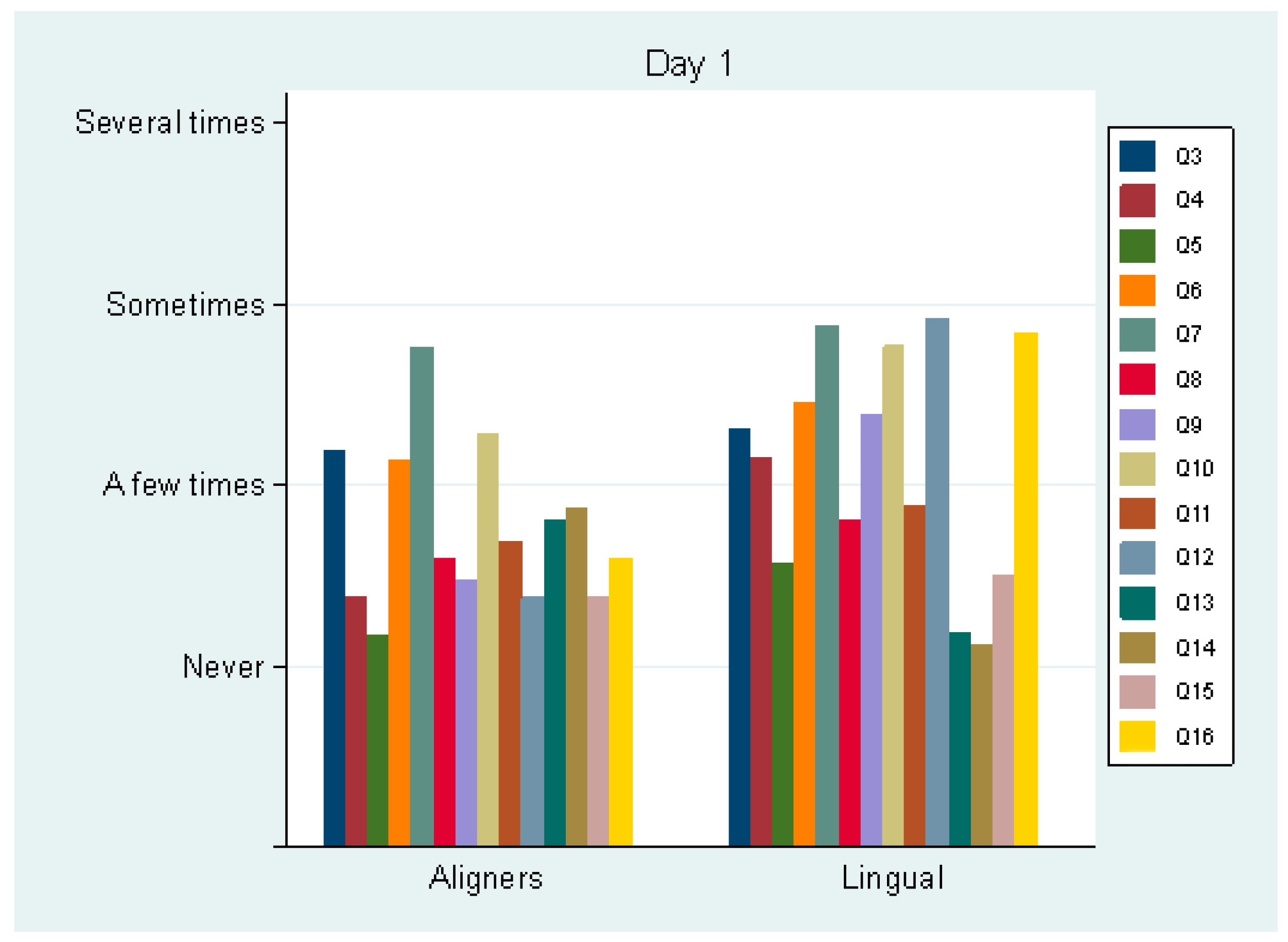
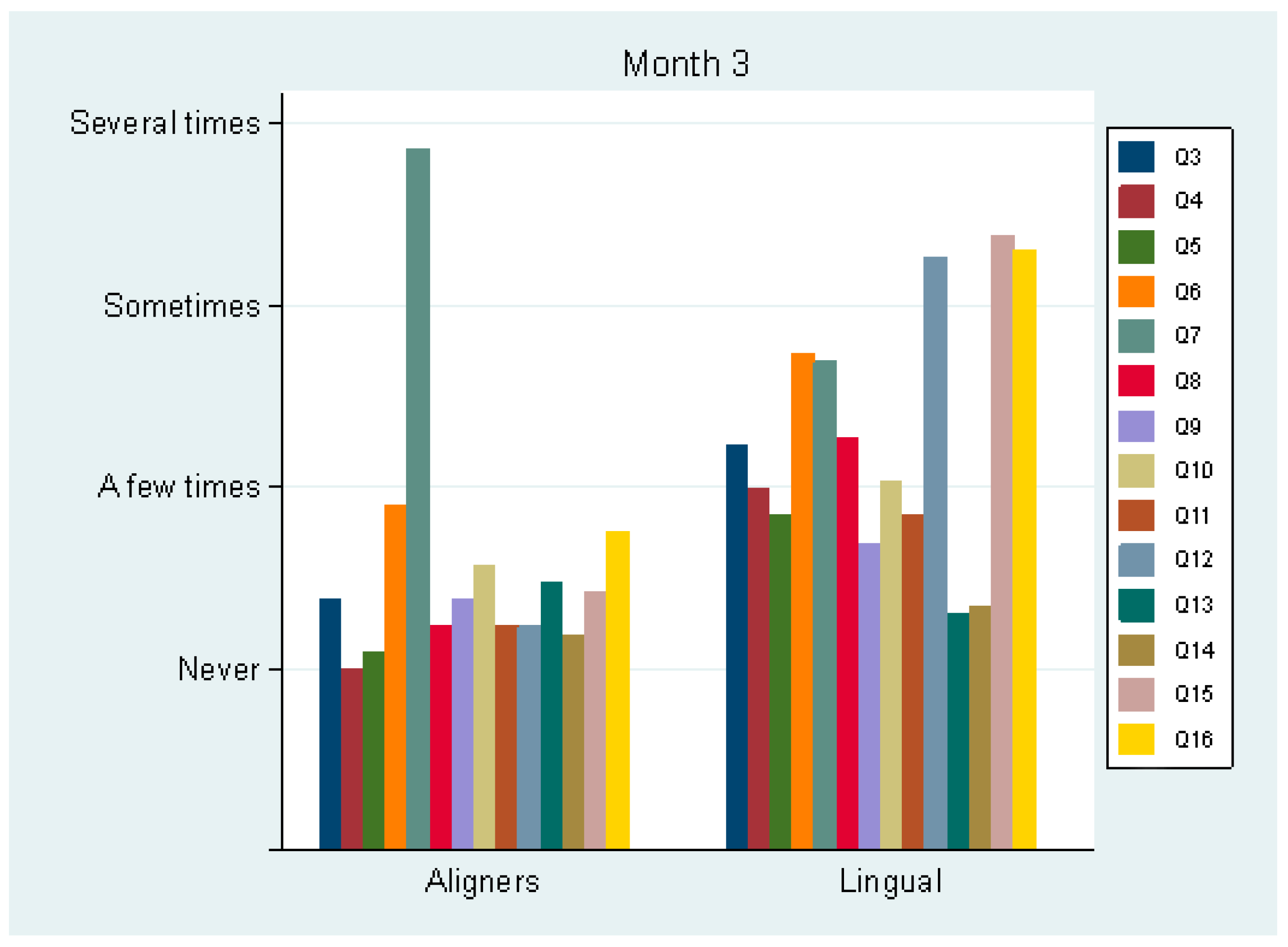
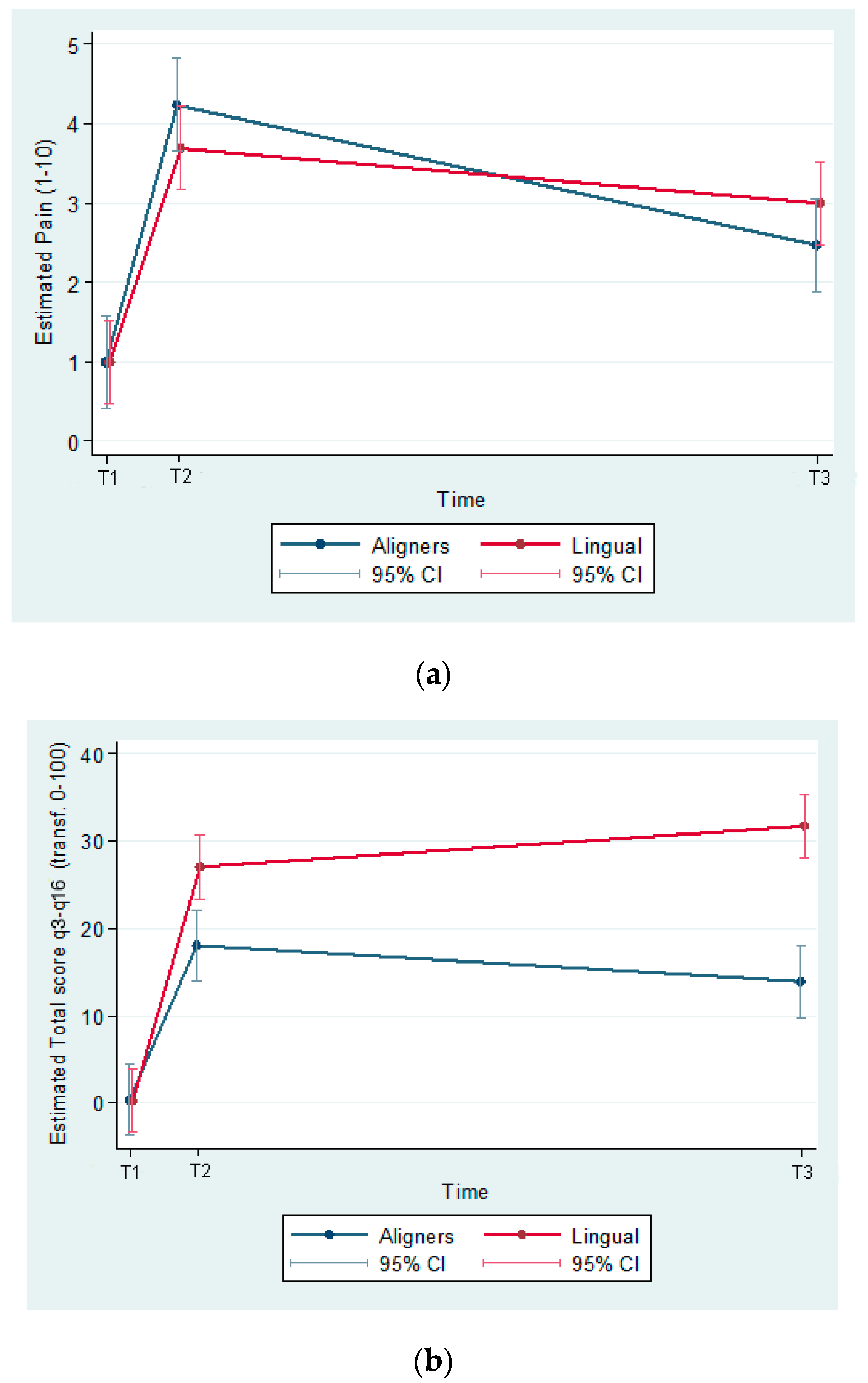
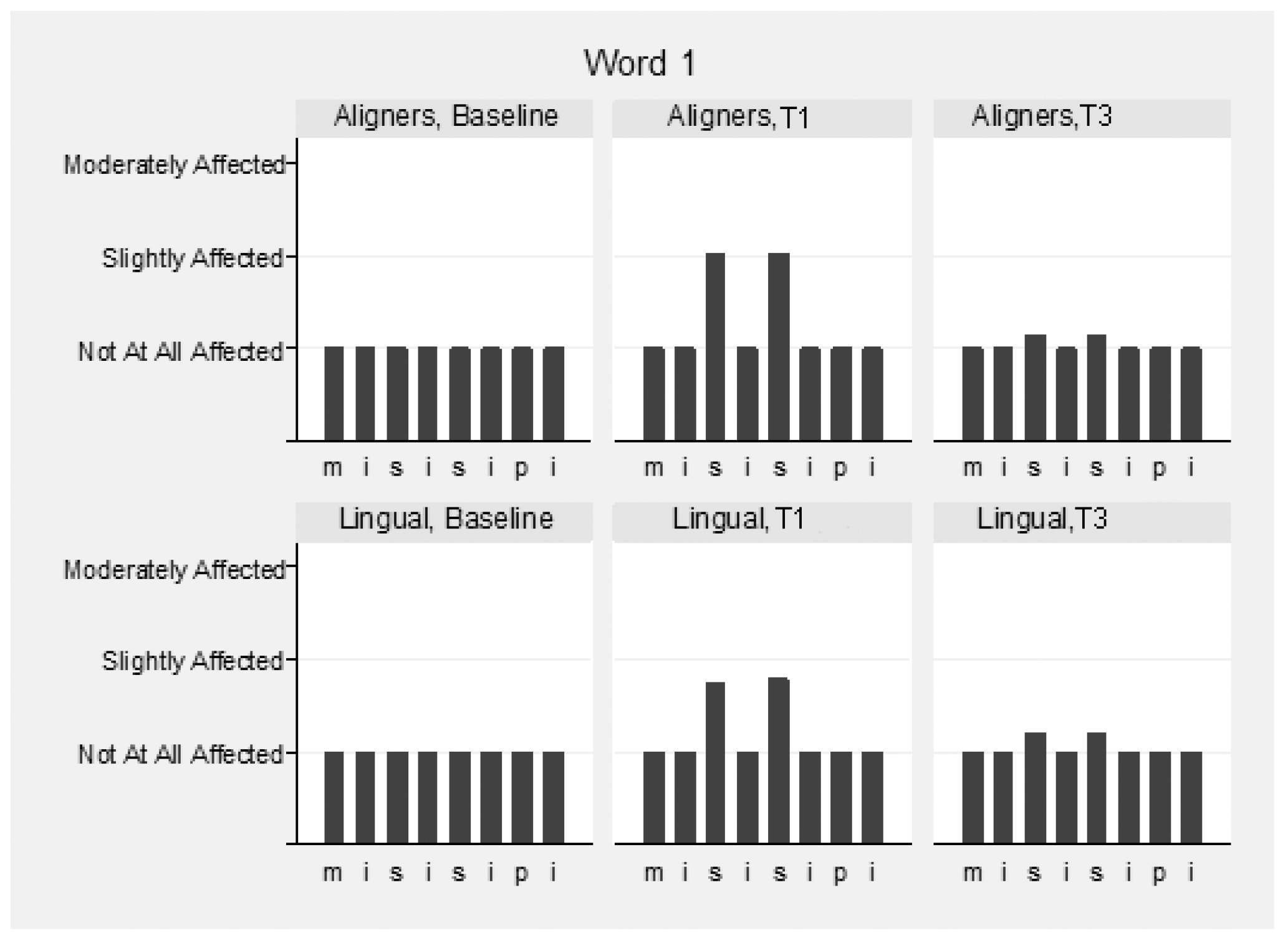
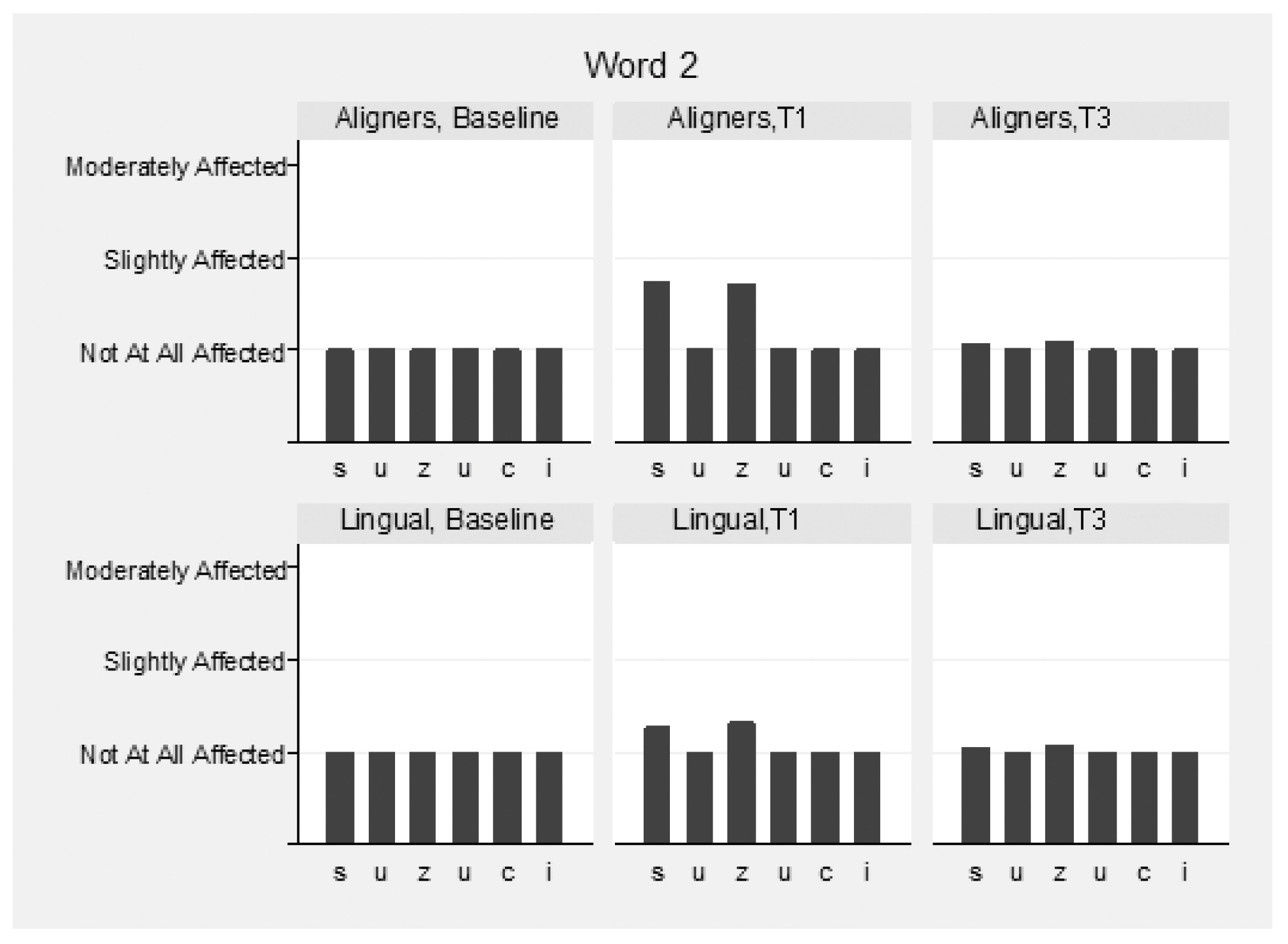
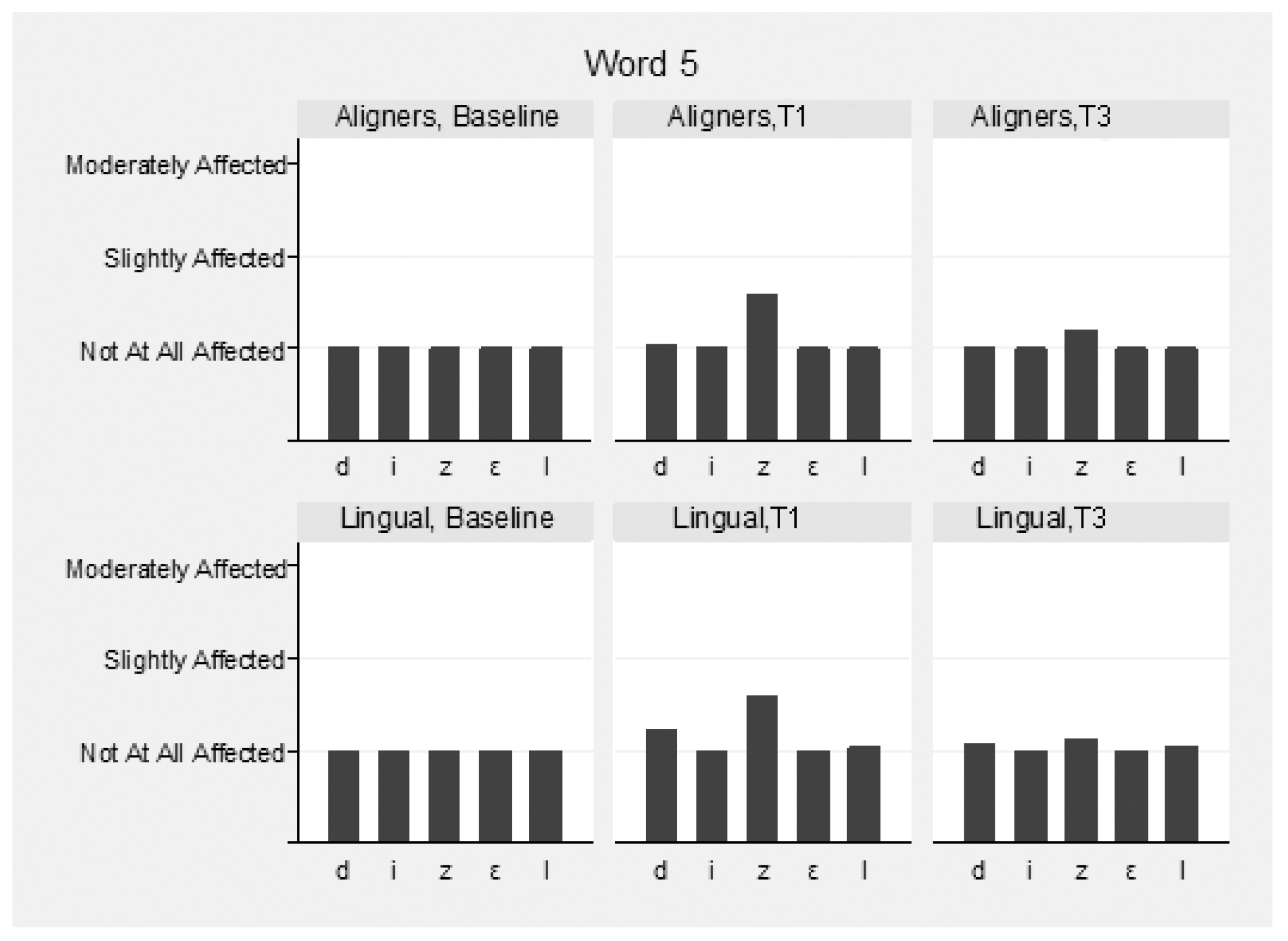

| Aligners | Lingual | Overall | ||
|---|---|---|---|---|
| N = 21 | N = 26 | N = 47 | p-Value | |
| Gender | 0.758 | |||
| Female (N, %) | 13 (61.9) | 18 (69.2) | 31 (66.0) | |
| Male (N, %) | 8 (38.1) | 8 (30.8) | 16 (34.0) | |
| Age (years, mean ± SE) | 32.9 (2.38) | 38.5 (2.12) | 36.0 (1.62) | 0.085 |
| Aligners | Lingual | Overall | p-Value | |
|---|---|---|---|---|
| ANB | 2.19 (2.7) | 2.00 (2.8) | 2.09 (2.7) | 0.816 |
| GoGn-SN | 31.15 (4.6) | 31.14 (3.7) | 31.15 (4.1) | 0.993 |
| U1-PP | 111.51 (7.9) | 110.30 (5.9) | 110.84 (6.8) | 0.554 |
| L1-MP | 96.02 (7.9) | 94.15 (4.9) | 94.99 (6.4) | 0.327 |
| Z-angle | 77.95 (5.0) | 78.30 (5.3) | 78.14 (5.1) | 0.822 |
| Aligners | Lingual | Overall | ||
|---|---|---|---|---|
| N (%) | N (%) | N (%) | p-Value | |
| Aesthetic Component | 0.775 | |||
| 1 | 3 (14.3) | 1 (3.8) | 4 (8.5) | |
| 2 | 2 (9.5) | 6 (23.1) | 8 (17.0) | |
| 3 | 5 (23.8) | 7 (26.9) | 12 (25.5) | |
| 4 | 2 (9.5) | 4 (15.4) | 6 (12.8) | |
| 5 | 2 (9.5) | 3 (11.5) | 5 (10.6) | |
| 6 | 3 (14.3) | 1 (3.8) | 4 (8.5) | |
| 7 | 3 (14.3) | 0 (0.0) | 3 (6.4) | |
| 8 | 1 (4.8) | 4 (15.4) | 5 (10.6) | |
| Dental Component | 0.264 | |||
| 2 | 3 (14.3) | 3 (11.5) | 6 (12.8) | |
| 3 | 11 (52.4) | 9 (34.6) | 20 (42.6) | |
| 4 | 5 (23.8) | 10 (38.5) | 15 (31.9) | |
| 5 | 2 (9.5) | 4 (15.4) | 6 (12.8) |
Publisher’s Note: MDPI stays neutral with regard to jurisdictional claims in published maps and institutional affiliations. |
© 2021 by the authors. Licensee MDPI, Basel, Switzerland. This article is an open access article distributed under the terms and conditions of the Creative Commons Attribution (CC BY) license (https://creativecommons.org/licenses/by/4.0/).
Share and Cite
Angelopoulos, G.G.; Kanarelis, P.; Vagdouti, G.; Zavlanou, A.; Sifakakis, I. Oral Impacts of Aligners versus Fixed Self-Ligating Lingual Orthodontic Appliances. Appl. Sci. 2021, 11, 10074. https://doi.org/10.3390/app112110074
Angelopoulos GG, Kanarelis P, Vagdouti G, Zavlanou A, Sifakakis I. Oral Impacts of Aligners versus Fixed Self-Ligating Lingual Orthodontic Appliances. Applied Sciences. 2021; 11(21):10074. https://doi.org/10.3390/app112110074
Chicago/Turabian StyleAngelopoulos, Gerassimos G., Panagiotis Kanarelis, Georgia Vagdouti, Ageliki Zavlanou, and Iosif Sifakakis. 2021. "Oral Impacts of Aligners versus Fixed Self-Ligating Lingual Orthodontic Appliances" Applied Sciences 11, no. 21: 10074. https://doi.org/10.3390/app112110074
APA StyleAngelopoulos, G. G., Kanarelis, P., Vagdouti, G., Zavlanou, A., & Sifakakis, I. (2021). Oral Impacts of Aligners versus Fixed Self-Ligating Lingual Orthodontic Appliances. Applied Sciences, 11(21), 10074. https://doi.org/10.3390/app112110074






